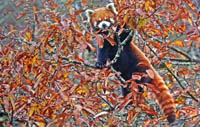|
# |
Species
[range] |
Photo/art [see credits]
all photos taken in wild unless stated |
Reason for choice |
DR seen? |
31 |
Red Panda
Ailurus fulgens
[e. Himalayas & sw. China]
|
|
Red Panda is the only living member of the family Ailuridae. It is not related to Giant Panda [weasels & raccoons are closer relatives]. It is a beautiful arboreal animal that eats bamboo, and is mostly nocturnal. There are spots in the Himalayas where day roosting individuals may be seen, with luck. There may be two species involved. |
No |
32 |
Numbat
Myrmecobius fasciatus
[w. Australia] |
|
This diurnal marsupial is now
limited to sw. Australia. It is shy and elusive in eucalyptus forests.
It feeds primarily on
termites, and requires a large home range. Once more widespread, predation by non-native foxes and
habitat loss have made it rare. See my Numbat page. |
Yes |
| 33 |
Giant Armadillo
Priodontes maximus
[s. South America] |
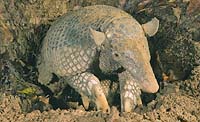 |
Enormous size and strictly nocturnal habits characterize this scarce and elusive armored mammal. I've seen its huge burrows in Emas NP in Brazil — indeed, our van crashed into one and got stuck — but even the locals rarely seen one. It is another of those "almost hopeless" mammals to see, and well represents its unique family. |
No |
| 34 |
Fossa
Cryptoprocta ferox
[Madagascar] |
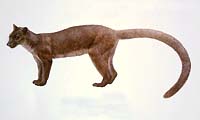 |
This is the largest predator in Madagascar, and the largest in the recently recognized family Eupleridae, the Madagascar carnivores. It can be diurnal or nocturnal, and is a forest mammals that is everywhere scarce and often declining. |
No |
| 35 |
Indri
Indri indri
[e. Madagascar] |
 |
The largest of Madagascar's lemurs, the Indri is nearly tail-less but lives in the canopy. The antiphonal haunting calls are a real forest experience. Their range is now fragmented as numbers decline; the Perinet Reserve was established to help save them. There are about a dozen very colorful lemurs (patterns of black, white, red or orange) in Madagascar. |
Yes |
|
36 |
any Colugo
Galeopterus variegatus, Cynocephalus
volans
[se. Asia] |
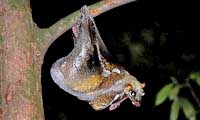 |
Often called "flying lemur,"
these are neither fly nor are lemurs. Rather, the two Colugos are
distinctive gliding mammals, like huge flying squirrels, but with a
head that resembles a small hornless deer. Bornean Colugo glides at
dusk in primary forests. Philippine Colugo is limited to a very few
Philippine islands. |
Yes; 1 of 2 |
|
37 |
any Sirenid
Dugong
Dugong dugong or any manatee Trichechidae
sp.
[tropical coasts] |
|
The five species of family
Sirenia [sea-cows] are found in warm coastal waters. Dugong ranges from
e. Africa to se. Asia & Australasia. The 4 manatees are West
Indian T. manatus, Amazonian T.
inunguis and Dwarf T. bernhardi [both Amazon basin] and West African T. senegalensis.
Each is a real treat to observe in the wild. |
Yes, 1 of 5 |
| 38 |
Giant Otter
Pteronura brasiliensis
[South America] |
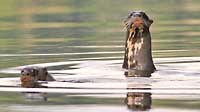 |
It is great fun to watch the
antics of any of the world's 13 otter species. I like sea otters (I can
see them daily where I live) but I am particularly attracted to
freshwater species. Giant Otter is the largest, is now considered
Threatened, and exists only in remote Amazonian Basin and Pantanal wilderness. A
fine choice indeed. |
Yes |
39 |
any Tapir
Tapirus sp.
[Neotropics & tropical Asia] |
|
Any tapir is a treat. The size of a donkey, they are generally elusive in the dense jungle. Brazilian T. terrestris (left) is the most common and widespread. Mountain T. pinchaque & Baird's T. bairdii are also in the Neotropics but both are endangered. The black-and-white Malayan T. indicus is very rare in se. Asia. |
Yes, 1 of 4 |
| 40 |
Narwhal Monodon monoceros
[Arctic oceans] |
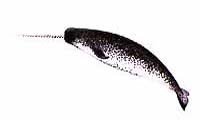 |
Narwhal and Beluga (Delphinapterus leucas) roam the Arctic Ocean and are the two living members of family Monodontidae. Male Narwhals have a long tusk — a protruding left canine — that identifies social status among a Narwhal pod, but its further function is uncertain. It might be a weapon, a tool for feeding, or in attracting mates. It is very unusual tusk — a "unicorn" among cetaceans — and it would be great to see. |
No |
